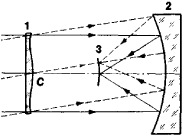Schmidt telescope
(Schmidt camera; Schmidt) A catadioptric wide-field telescopic camera first built in 1930 by the Estonian Bernhard Schmidt (see catadioptric telescope). A short-focus reflecting telescope with a spherical mirror suffers from severe spherical aberration. This is normally corrected by modifying the surface to a paraboloid. This method of correction is effective, however, only for a field of less than half a degree: outside this limit the star images are distorted by severe coma. Schmidt overcame the spherical aberration of a spherical mirror, which does not suffer from coma, by placing a correcting plate in the incoming light beam before it reached the short-focus spherical primary mirror. His correcting plate is a thin plate of complicated figure placed near the center of curvature of the mirror (see illustration). The corrected light comes to a focus on a curved focal surface but when a photographic plate is sprung to this curve very sharp star images are formed upon it over a field of maybe tens of degrees: the 1.2-meter UK Schmidt telescope covers 40 square degrees of sky. In addition relatively short photographic exposures are required, compared to a normal telescope, because of the small focal ratio of the Schmidt. The description ‘1.2 m/1.8 m/3.1 m Schmidt’ indicates that the correcting plate has a diameter of 1.2 meters, and the spherical mirror a diameter of 1.8 m and a focal length of 3.1 m. This is normally abbreviated to ‘1.2-m Schmidt’.The development of the Schmidt telescope has enabled whole-sky surveys, such as the Palomar Observatory Sky Survey and Southern Sky Survey, to include very faint (down to about 21st magnitude) stars. Information, in digital form, can now be extracted rapidly and automatically from the photographic plates using machines such as COSMOS.
The Schmidt–Cassegrain configuration offers a more accessible focal surface behind the primary mirror (which has a central hole) by means of an additional small convex mirror placed between correcting plate and primary (see Cassegrain configuration). This adaptation gives high-quality images over a reasonably wide field, and the focal surface can be flattened if at least one of the two mirrors is aspheric.
The super Schmidt is an extreme form of Schmidt developed by the American James Gilbert Baker in the late 1950s. By employing additional correcting plates he was able to retain the wide field while increasing the speed to focal ratios approaching 0.5. (Schmidt's original telescope was f/1.7). These extremely fast cameras were designed to record meteor and artificial satellite trails.
Schmidt Telescope
an astronomical mirror-lens telescope designed for photographing large areas of the sky. The Schmidt telescope was invented in 1929 by the German opticist B. Schmidt. Its main components are a spherical mirror and a Schmidt correction plate, which is mounted at the center of curvature of the mirror (see Figure 1). As a result of the placement of the correction plate, all beams of rays passing through it from different parts of the sky prove to be equally corrected with respect to the mirror. Consequently, the Schmidt telescope lacks such aberrations of optical systems as coma, astigmatism, and distortion.

The spherical aberration of the mirror is corrected by the correction plate, the central part of which acts as a weak positive lens, and the outer part, as a weak negative lens. The focal surface, on which the image of a segment of the sky is formed, has a spherical shape, whose radius of curvature is equal to the focal distance of the telescope. The focal surface can be converted into a flat surface by means of a Piazzi-Smyth lens. In small Schmidt telescopes, the field of view is limited by a cassette that screens the beam of rays incident on the mirror; in large Schmidt telescopes, it is limited by the aberrations of oblique rays, which are introduced by the correction plate. This plate, in correcting spherical aberrations, gives rise to small residual aberrations (coma and astigmatism), which spoil the image. The chromatism of the correction plate limits the relative aperture of Schmidt telescopes and the operating region of the spectrum. A Schmidt telescope with a primary mirror of a small diameter at a relative aperture A = 1:1 provides a field of view 20° in diameter; at larger diameters of the primary mirror and at A from 1:2 to 1:3, the diameter of the field of view is about 5°. To eliminate vignetting of the rays at the edge of the field, the diameter of the primary mirror must exceed the diameter of the correction plate by 4l, where 2l is the diameter of the field of view in linear measurement.
A shortcoming of Schmidt telescopes is the considerable length of the tube, which is twice the focal length of the telescope. A number of modifications, including the use of a second (supplementary) convex mirror and the placement of the correction plate closer to the primary mirror, have been proposed to eliminate this shortcoming.
The largest Schmidt telescopes are mounted at the astronomical observatory in Tautenberg in the German Democratic Republic (D = 1.37 m, A = 1:3), the Mount Palomar Observatory in the United States (D = 1.22 m, A = 1:2.5), and the Biurakan Astrophysical Observatory of the Academy of Sciences of the Armenian SSR (D = 1.00 m, A = 1:2,1:3).
REFERENCES
Dimitroff, G., and J. Baker. Teleskopy i prinadlezhnosti k nim. Moscow-Leningrad, 1947. (Translated from English.)Teleskopy. Edited by G. Kuiper and B. Middlehurst. Moscow, 1963. (Translated from English.)
Mikhel’son, N. N. Opticheskie teleskopy: Teoriia i konstruktsiia. Moscow, 1976.
Linfoot, E. H. Recent Advances in Optics. Oxford, 1955.
N. N. MIKHEL’SON
